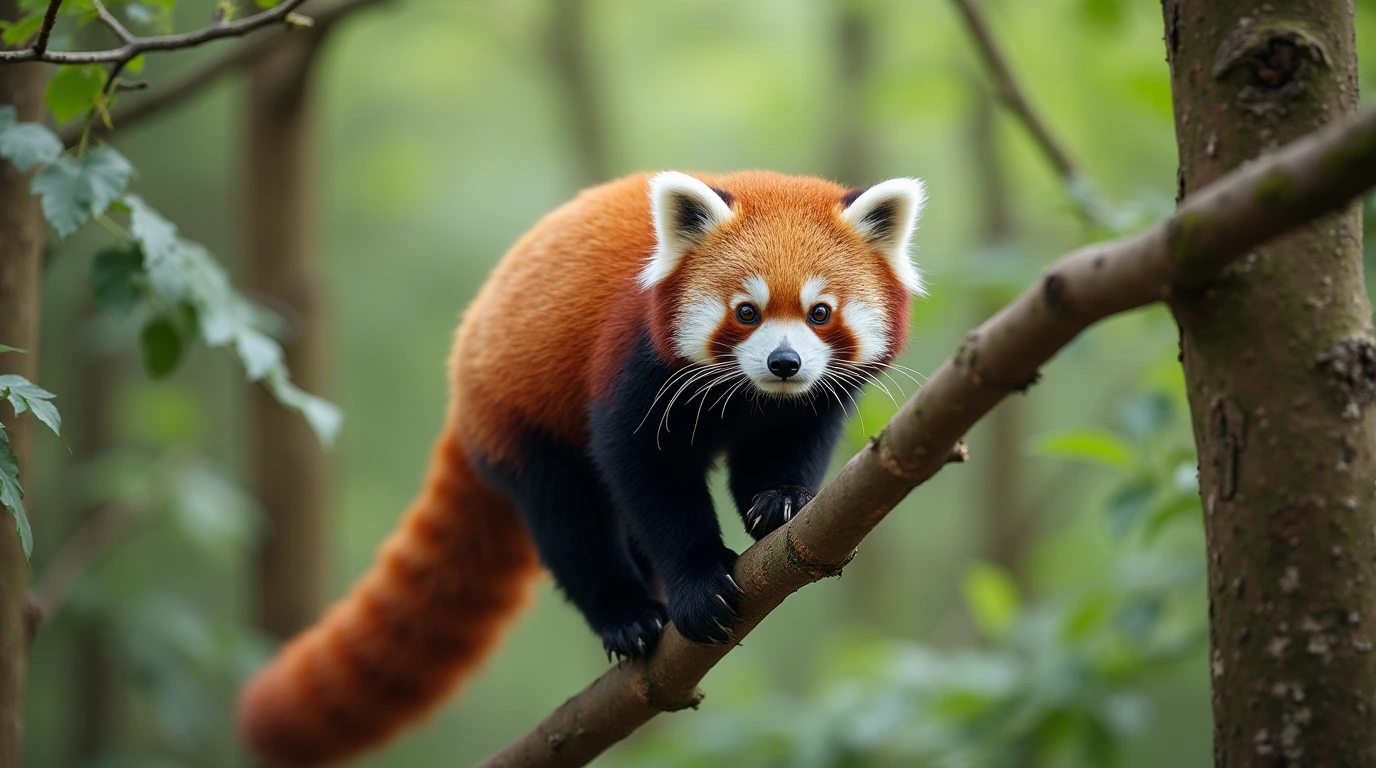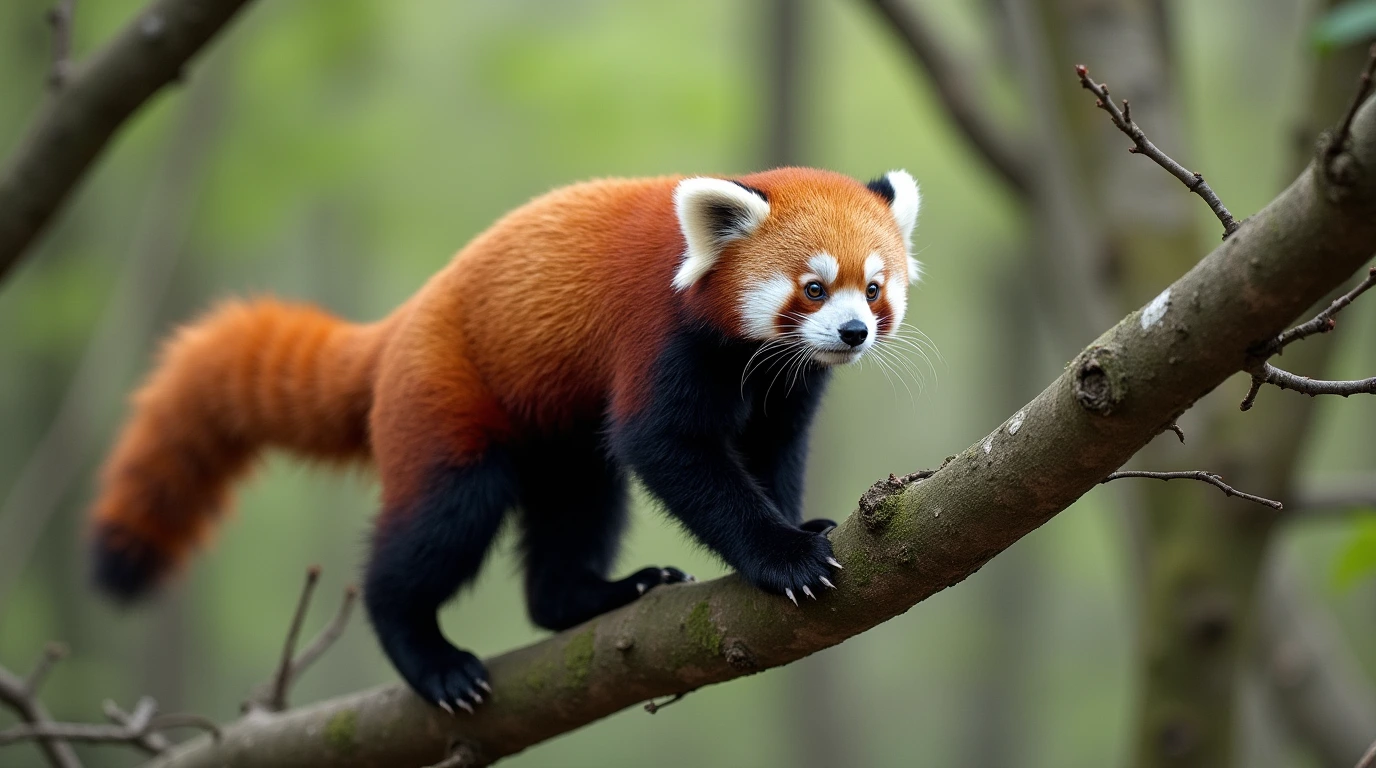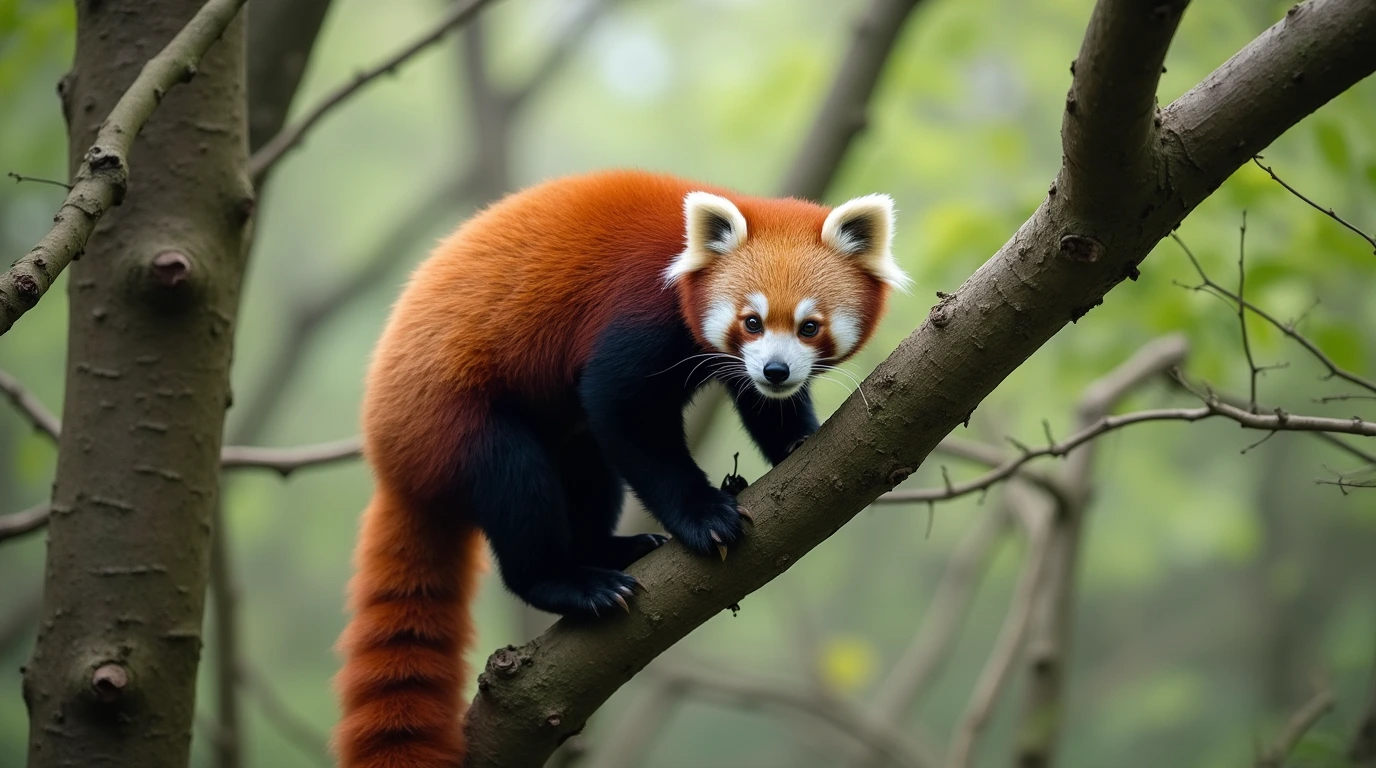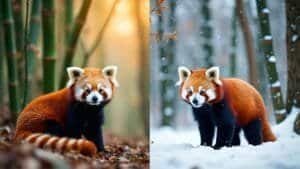The red panda’s small size is one of its most important adaptations for life in the trees. Weighing between 8 and 14 pounds and measuring just over two feet in length, this compact and lightweight body structure enables the red panda to move with ease and precision through dense forest canopies. Unlike larger animals, which may struggle to balance or maneuver on thin branches, red pandas can access high, narrow, and flexible parts of the forest that offer food, shelter, and escape routes from predators
Their body mass is perfectly suited for climbing, aided by semi-retractable claws and a long bushy tail that provides counterbalance. These traits not only allow them to exploit the vertical space of their habitat efficiently but also protect them from threats on the ground. In this article, we’ll explore the vital role of the red panda’s size in its arboreal lifestyle, from movement and feeding to predator evasion and energy conservation. We’ll also look at how its physical form compares to other tree-dwelling mammals and the challenges that come with being small in a forest filled with dangers
How the Red Panda’s Small Size Supports Arboreal Living

Red pandas thrive in the dense, mountainous forests of the eastern Himalayas and southwestern China, where their compact size provides a significant evolutionary advantage. Their ability to climb trees, balance on narrow branches, and access remote areas of the canopy is directly influenced by their lightweight and agile body structure
Average Size and Weight of the Red Panda
The red panda’s body length typically ranges from 22 to 25 inches, with an additional 14 to 19 inches attributed to its thick, bushy tail. Adults weigh between 8 and 14 pounds, with males being slightly heavier than females. This size places them in the same weight class as domestic cats, which makes them ideal candidates for a life spent navigating the treetops
Their relatively small size allows them to move swiftly through the forest canopy, reach food sources that larger animals cannot access, and hide in compact resting spots during the day. According to the Smithsonian’s National Zoo, this lightweight physique not only enables ease of movement but also contributes to their stealth, a critical defense mechanism in predator-rich environments
Benefits of a Compact Body for Tree Movement
A compact frame gives the red panda greater control over its body while climbing and foraging in trees. Their small mass minimizes the risk of slipping or breaking branches, allowing them to venture into more fragile parts of the canopy where food sources like bamboo leaves and fruit are plentiful. Their short limbs and flexible joints provide excellent maneuverability in tight or complex spaces, helping them adjust their posture quickly while moving between trunks, branches, and vines
Because they are not burdened by the inertia of a larger body, red pandas can change direction rapidly, an essential trait for avoiding falls or retreating when startled. This agility is especially useful in high-altitude forests where vertical movement is essential not only for food access but also for protection. Their ability to climb high and move silently through the canopy makes them elusive to both predators and researchers
The Role of the Tail in Balancing and Climbing
One of the most prominent features that supports the red panda’s arboreal lifestyle is its long, bushy tail. This tail, which can reach up to 19 inches in length, acts as a natural counterbalance when the panda is navigating narrow branches. It stabilizes the animal’s body during climbing and movement, much like a tightrope walker uses a pole for balance
The tail also serves multiple functions beyond balance. It provides warmth during cold Himalayan nights, as red pandas often curl up and wrap the tail around themselves like a blanket. Furthermore, it enhances camouflage, blending with the reddish hues of mosses and lichen-covered tree bark, especially in low light
The Redwood Zoo notes that red pandas use their tail strategically not just for balancing but also when climbing down trees—a behavior many animals avoid due to the risk of falling. Their combination of size, balance, and tail use makes them among the most agile climbers in their ecosystem
By leveraging their small size and specialized physical features, red pandas are able to occupy a niche in the forest canopy that is inaccessible to many other species. Their ability to move with precision, balance effectively, and evade ground-based threats gives them a distinct advantage in the vertical complexity of their environment
Physical Adaptations Enhancing Arboreal Navigation

In addition to their small size, red pandas possess several specialized physical traits that enhance their ability to climb, balance, and move through trees with remarkable agility. These adaptations allow them to live almost entirely above ground, where they forage, rest, and evade predators. The synergy between body size and physical design plays a defining role in the red panda’s arboreal lifestyle
Claw Functionality and Tree-Gripping Ability
Red pandas are equipped with sharp, semi-retractable claws that play a central role in their climbing ability. These claws act like hooks, allowing them to latch onto tree bark, bamboo stalks, and branches securely. Their forelimbs and hindlimbs work together to grip and pull, giving them excellent traction on both vertical and horizontal surfaces
In combination with their flexible ankles, which can rotate outward nearly 180 degrees, red pandas can descend trees headfirst—a rare trait among mammals. This ability gives them an edge when fleeing from predators, enabling quick downward escapes without needing to turn around or risk falling. The secure grip from their claws ensures stability during such rapid descents, especially in wet or snow-covered conditions common in their high-altitude forest homes
According to the Redwood Zoo, red pandas rely on these claws not just for climbing but also for feeding. Their claws allow them to strip bamboo leaves from stalks with precision and climb out onto the thinnest branches in search of tender shoots
Lightweight Advantage in Forest Canopies
Being lightweight is essential for survival in the canopy. Red pandas can distribute their body weight across fragile branches without causing breakage, allowing them to explore parts of the tree that larger animals cannot access. This opens up food sources, like bamboo leaves, fruit, and berries, that are located near the tree’s periphery—an area too unstable for heavier climbers
Their ability to perch and feed in these delicate areas without damaging the vegetation is not just a benefit to their own survival but contributes to the health of the forest. By grazing lightly on leaves and moving gently through the trees, red pandas minimize their ecological footprint. In this way, their body size enables not just movement but a sustainable coexistence with the environment
In denser areas of the canopy, where space is limited and branch networks are complex, their small mass and narrow body shape give them a mechanical advantage. They can twist, turn, and pivot through foliage and vines without causing disruption or making noise—an advantage when evading predators or moving unnoticed through a territory shared with other animals
Size-Based Escape Tactics from Predators
One of the key benefits of being small in a forest ecosystem is the ability to disappear quickly. Red pandas are masters at using their size to escape danger, often disappearing into dense foliage or ascending trees in a matter of seconds. Their small bodies allow them to slip through tight spaces and climb swiftly, placing them out of reach of larger ground-based predators such as snow leopards or feral dogs
Even when pursued in the trees by agile predators like martens, red pandas can retreat onto thinner branches that cannot support the predator’s weight. They also make use of tree hollows or forked trunks to hide, locations that are difficult to access or detect from the ground
The International Fund for Animal Welfare (IFAW) highlights that this behavioral use of vertical space is not only effective for avoiding threats but also a vital part of their role in the ecosystem. By remaining high in the canopy, red pandas limit interaction with other species and help preserve the structural diversity of their habitat
Their small size, therefore, is not a limitation—it is a strategic adaptation that supports stealth, mobility, and survival. From their claws and flexible ankles to their tail-assisted balance and branch agility, the red panda’s physical profile is uniquely designed for tree life
Trade-Offs and Challenges of Small Arboreal Mammals

While the red panda’s small size offers many advantages in arboreal environments, it also comes with certain trade-offs. These challenges, including energy constraints, thermoregulation issues, and vulnerability to specific predators, require compensatory adaptations. Red pandas have evolved behaviors and physical traits that help offset the risks associated with their compact stature, allowing them to survive and thrive in their niche
Energy and Thermoregulation Constraints
A small body mass means a higher surface-area-to-volume ratio, which causes red pandas to lose body heat more quickly than larger animals. In their cold, high-altitude environments, this presents a serious challenge. To combat heat loss, red pandas have dense fur that covers their entire body, including the soles of their feet. Their fur not only insulates them but also protects them from wet and snowy conditions
Additionally, red pandas have a relatively low metabolic rate compared to other mammals of similar size. This helps them conserve energy, which is especially important given their bamboo-based diet that is low in calories. Their slow metabolism reduces their need for food intake and helps them survive during times of food scarcity, such as winter, when bamboo leaves are tougher and less nutritious
To further conserve energy, red pandas are crepuscular and nocturnal, minimizing activity during the hottest or coldest parts of the day. They also spend much of their time resting, curled up in tree branches or hollows, often using their tails as insulation blankets to retain warmth. These thermoregulatory and metabolic adaptations are key compensations for the energy constraints associated with small body size
Vulnerability to Aerial and Agile Predators
Although red pandas can escape many ground-dwelling predators by climbing, their size makes them more susceptible to aerial predators like large raptors and tree-climbing carnivores such as yellow-throated martens. These predators can pursue them into the canopy or strike from above, making vigilance and stealth critical to their survival
To reduce their visibility, red pandas rely heavily on camouflage. Their reddish-brown fur matches the color of tree bark, mosses, and lichen found in their habitat, helping them remain hidden in plain sight. At night, when many predators are less active, red pandas emerge to forage, reducing the chance of being seen or tracked. Their silent movement through foliage and preference for complex tree structures add additional layers of security
However, red pandas do not possess significant strength or speed to fight off attackers. Their primary defense remains evasion—using tight spaces, narrow branches, and tree hollows to escape. This strategy is effective but underscores the vulnerability that comes with being small and lacking physical defenses
Adaptations That Offset Size-Related Risks
To balance out the risks of being small, red pandas have developed a combination of physical and behavioral traits that enhance their survival. One of the most notable is their pseudo-thumb, an extended wrist bone that helps them grip bamboo and climb with precision. This adaptation allows them to feed efficiently and maintain control while navigating tree limbs
Their strong, curved claws support their grip, allowing them to ascend and descend trees safely, even when the surface is steep or slippery. Their ability to rotate their ankles outward gives them an edge in agility and escape, enabling them to descend trees headfirst and react quickly to threats
Behaviorally, red pandas avoid unnecessary movement during the day, minimizing energy use and reducing exposure to predators. They often establish sleeping spots high in the trees and return to familiar routes that provide safety and access to food. In fragmented habitats or areas with human activity, they may become even more nocturnal, reducing overlap with both predators and people
Despite the trade-offs associated with small size, red pandas have adapted remarkably well to arboreal life. Their combination of physical traits, behavioral adjustments, and ecological flexibility allows them to occupy a unique niche in their ecosystem. As highlighted by the Smithsonian’s National Zoo, red pandas represent an extraordinary balance between form and function, perfectly tailored to thrive in the vertical world of the forest canopy













